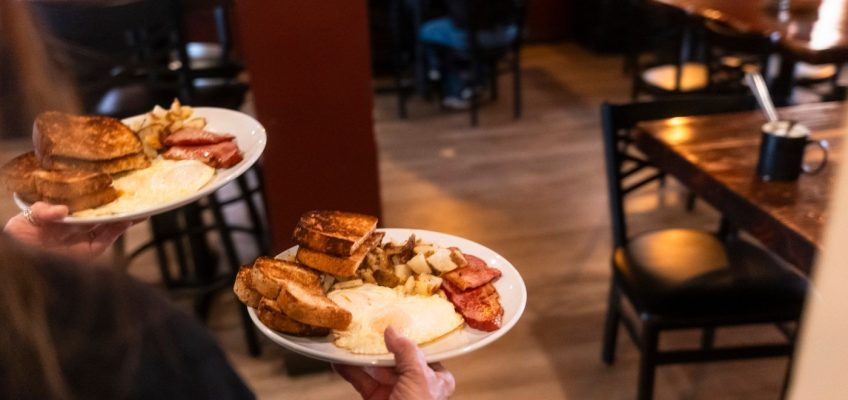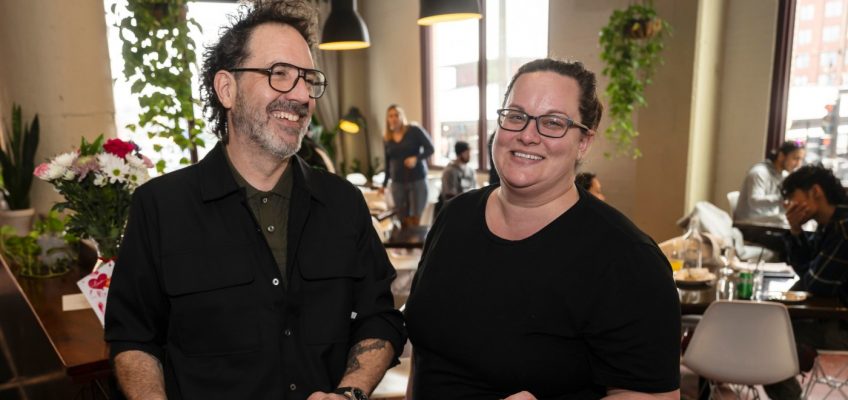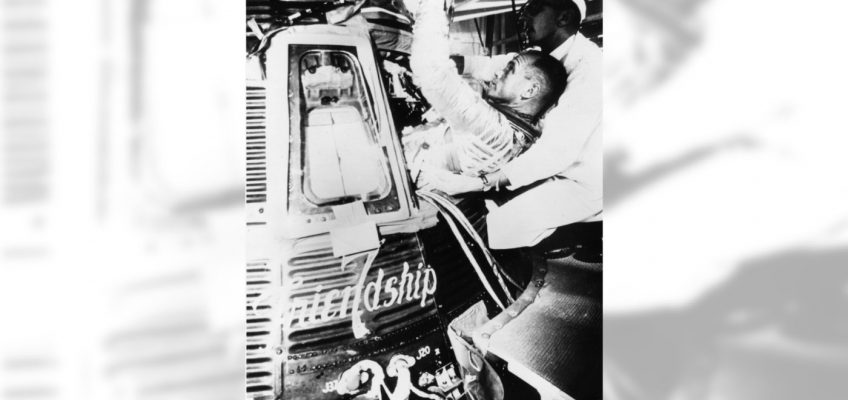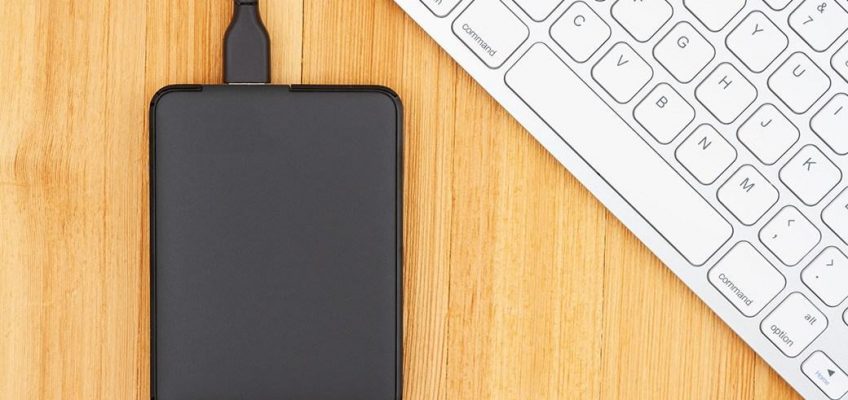Karen Huebner did not want to raise the price of omelets.
Even as she was paying more for eggs week after week, she held prices steady on over-easy dishes and breakfast burritos and other customer favorites at the Hot Grillz Diner, the small, restaurant her family owns in Walton Hills, Ohio, about 15 miles southeast of Cleveland.
But last week, as shortages pushed the cost of her egg order to nearly $1,000, from $300 about a month ago, the moment had arrived.
Karen Huebner, the owner of Hot Grillz Diner in Walton Hills, Ohio, Feb. 12, 2025. “My loyal customers would rather pay 50 cents more an egg right now than to see these doors close because I can’t pay my rent,” said Huebner. (Daniel Lozada/The New York Times)
“I said I wasn’t going to do it, but this is crushing me,” Huebner said. “My loyal customers would rather pay 50 cents more an egg right now than to see these doors close because I can’t pay my rent.”
As the wholesale price of eggs — what retailers and restaurants pay — rises, hitting a new high of $8.11 a dozen, breakfast specials at some restaurants are getting more expensive.
Waffle House announced on Feb. 3 that it would add a temporary surcharge of 50 cents for each egg used in dishes. Across the country, smaller restaurant chains and bakeries that use a lot of eggs are either bumping prices up or adding temporary surcharges, trying to pass along some of the expense to inflation-weary customers.
“If you raise prices too much, you risk losing the customers,” said Ed Powers, the director of operations at Broken Yolk Cafe, a chain of 40 restaurants, largely in the West, where 70% of the menu items require eggs. The company has cut costs where it can, but it is considering raising the prices of its egg dishes. “What’s a fair price for an omelet?”
Making scrambled eggs at home isn’t much cheaper these days, either. Shoppers at many grocery stores, including Costco and Trader Joe’s, are finding sparsely filled shelves and signs limiting how many cartons of eggs they can buy at a time.
Those lucky enough to find eggs to buy are paying significantly more for them.
On Wednesday, the Labor Department reported that grocery prices, which had been relatively flat in late 2023 and early 2024, climbed 1.9% in January on a yearly basis, largely because of egg prices. The price of eggs to consumers has jumped 15.2% over the past four weeks. Since last year, egg prices are up 53%.
Nationally, a dozen Grade A eggs were $4.95 in January, up from $2.52 a year ago, according to FRED, the Federal Reserve Bank of St. Louis economic database. (Grocery stores typically price products like milk and eggs as “loss leaders,” meaning they are sold for less than the wholesale price that stores pay, to entice customers into a store.)
Soaring prices have also led to at least two egg heists. In early February, thieves stole 100,000 organic eggs worth $40,000 from a distribution trailer in Pennsylvania, and last week more than 500 eggs were taken in the early morning from a cafe in Seattle.
How much higher prices will go and how long they will last are hard to predict. While egg prices have been volatile, partly because of inflation, much of the recent spike is attributed to the avian influenza caused by the H5N1 virus. When a farm has a confirmed case of the virus, the whole flock needs to be slaughtered to contain the spread. More than 45 million chickens — roughly 15% of the nation’s egg-laying population — have been killed in the past four months to prevent the spread of the disease, according to Karyn Rispoli, the egg managing editor at Expana, which tracks the prices of eggs.
In early February, more confirmed cases of bird flu were reported in commercial egg-laying operations in Ohio and Pennsylvania, according to the U.S. Department of Agriculture.
Eggs at Hot Grillz Diner in Walton Hills, Ohio, Feb. 12, 2025. Since last year, egg prices are up 53 percent for consumers. (Daniel Lozada/The New York Times)
In New York, Gov. Kathy Hochul ordered all live bird markets in New York City and a few surrounding counties to close temporarily in an effort to stem the spread of the virus. Meanwhile, three ducks at the Queens Zoo died because of bird flu, and as many as 12 birds at the Bronx Zoo that had died after possible exposure were being tested for the virus, according to the Wildlife Conservation Society, the nonprofit that operates the parks.
Egg analysts say two things need to happen for egg prices to moderate: Confirmed cases of bird flu have to subside or end, giving egg-laying operations a chance to rebuild their flocks, and consumers need to curb their hoarding tendencies. Right now, some shoppers are buying eggs they don’t need but fear they won’t be able to get later.
“Consumers have largely adapted to higher grocery costs, so even at $5 per dozen, demand remains strong,” Rispoli said in an email during a morning when she was busy tracking egg prices. “And with eggs making national headlines daily, there may also be an element of panic buying, further fueling demand.”
Still, not all restaurants are raising prices. Some, like Cracker Barrel, are using the moment to gain a competitive advantage. Taking direct aim at Waffle House’s egg surcharge, Cracker Barrel said on social media not only that prices on egg dishes were “staying put,” but also that the chain’s loyalty rewards customers would get double points ordering those items.
Broken Yolk Cafe has tried to hold menu prices firm, even as the price of its primary ingredient soared. Instead, it tried to cut other costs, such as reducing credit card fees and working with suppliers to reduce the cost of restaurant supplies. It has also tried promotions of non-egg dishes, like a vegan burrito, but, Powers said, the chain has little choice but to increase prices for menu items made with eggs.
“It’s not even just cost at this point, it’s also supply,” Powers said, noting one restaurant in the chain that had put in its usual order for 20 cases of eggs (a case is 15 dozen eggs) received only eight from its supplier. “We’re being told it could take six to eight months before we see relief.”
Related Articles
As Saint Dinette says a long Minnesota goodbye, a look at the state of restaurants in Lowertown and beyond
A recipe from ‘Kapusta’: Cabbage Rolls with Sauerkraut Leaves, Beef and Rice in a Tomato Sauce
Eastern Europe’s traditional ingredients get star treatment in the new cookbook ‘Kapusta’
This smoky, buttery shrimp dinner is ready in no time
KFC is leaving its ancestral home as parent company moves its corporate office to Texas




